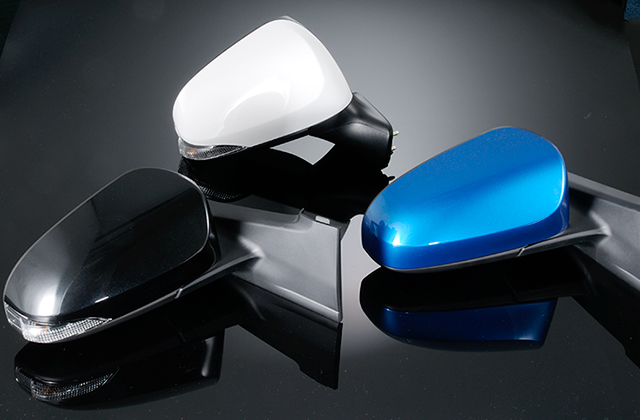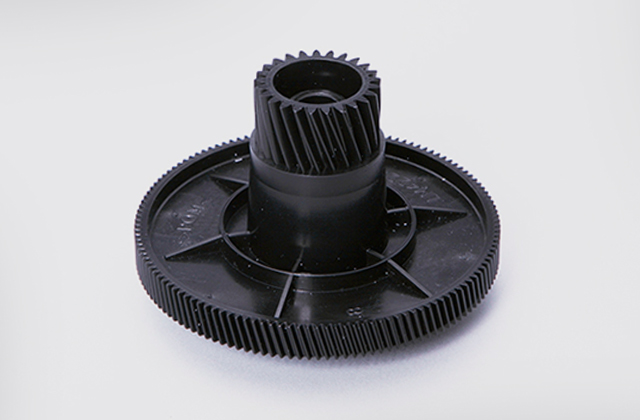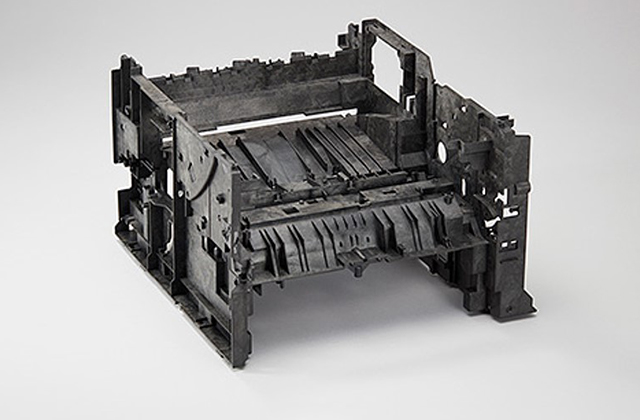- TOP
- Technical Support
- Resin Q&A
Resin Q&A
Products & Molds
QWhat is the relationship between GF orientation and product design precautions?
Glass fiber reinforced materials demonstrate glass fiber aligned in the direction of flow during molding. Due to the orientation of glass fibers in flow and crossflow directions, the molding shrinkage rate and strength are different. Care must be taken in designing products.
Due to the orientation of glass-fiber, the molding shrinkage rate and strength will differ, so care must be taken when designing the product.
QWhat is actions for anti-warping?
The warpage is generated by the size of the molding shrinkage rate of plastic materials and anisotropy (difference between the machine dirrection and the transverse dirrection). Generally, crystalline resins have a larger molding shrinkage rate and tend to cause warping, and glass fiber-reinforced resins tend to cause warping due to the degree of glass fibers orientation which occur at different degree in flow direction vs perpendicular to flow direction. Therefore, measures are taken to reduce the anisotropy of the molding shrinkage rate, by reducing the wall thickness change and also by improving the gate balance, etc., and also by increasing the molding temperature and the cooling time from the viewpoint of molding conditions. In terms of material, among the inorganic filler reinforcement types, the inorganic filler combination type with less anisotropy , spherical and plate-like morphologies is effective in preventing warpage.
In general, crystalline resins have a large molding shrinkage rate and are prone to warping, and glass-fiber reinforced resins are prone to warping depending on the degree of orientation of glass-fiber during molding.
Therefore, ingenuity to reduce the anisotropy of molding shrinkage, improvement of shape setting and gate balance to reduce thickness change, and raising the mold temperature and lengthening the cooling time in terms of molding conditions, etc. take countermeasures.
In terms of materials, among the inorganic filler reinforced types, types with less anisotropy and spherical or plate-like inorganic fillers are effective in preventing warpage.
Q What is the relationship between molding shrinkage and water absorption dimensional change of Leona?
The molding shrinkage of Leona varies between grades with and without fiberglass and inorganic fillers. Molding shrinkage rates are lower for materials containing glass fibers or inorganic fillers than for materials that are not generally included with fillers. Leona is water-absorbing (moisture-absorbing) and has larger dimensions due to water absorption (moisture absorption).
Materials containing glass-fiber and inorganic fillers generally have smaller molding shrinkage than materials that do not contain them.
LEONA™ absorbs water (moisture), and its dimensions will increase as a result.
Molding
QWhat is annealing and humidity control?
Annealing refers to a heat treatment that is performed to stabilize dimensions or remove distortion after molding. Moisture control is a process for stabilize dimensions of hygroscopic material by forcibly moisture absorbed under a humidity atmosphere to and the like.
Humidity conditioning is the process of forcibly absorbing moisture in a hygroscopic material molded product in a humid atmosphere to stabilize its dimensions.
QHow to remove the mold deposit?
Mold deposits (mold contaminants) are mainly composed of additives, monomers, oligomers, etc. contained in resins. In order to remove these mold deposit, it is common practice to wash them with a solvent that dissolves them well. Asahi Kasei’s MD Buster™ and Buster Mild™ are effective.
The general method of removing these substances is to wash them with a solvent that dissolves them well, and Asahi Kasei 's "MD Buster" and "Buster Mild™" are effective.
QWhat is the rework material and the condition used?
Rework materials (recycled materials) are materials that are used by crushing sprue, runners, and defective products generated in the process. Generally, the crushed product is used as it is, or the crushed product is converted to pellet by extrusion. When rework materials are used, precautions such as the storage condition before and after rework, the number of rework times, the ratio of rework materials used (how much is mixed), and contamination with foreign matter are required.
In general, the pulverized product is used as it is after pulverization, or the pulverized product is extruded and used in the form of pellets.
When using reworked materials, it is necessary to pay attention to the storage conditions before and after rework, the number of times of rework, the usage rate of reworked materials (how much to mix), and foreign matter contamination.
QWhat is the effect of discoloration during drying on physical properties?
The color may change regardless of the material depending on the drying conditions (hot air or vacuum drying, temperature, and time). Generally, it is better to use the recommended temperature and within the recommended time, but even if it is at the recommended temperature, it may discolor if it dries for a long time. Discoloration does not affect the physical characteristics, but if it dries at a temperature higher than the recommended temperature for a long time the color could change drastically.
In general, 2 to 3 hours at 100°C or less is a guideline, but even at 100°C or less, drying for a long time may cause discoloration.
Even if there is discoloration, there is no effect on the physical properties.
QHow is the relationship between mold shrinkage rate and molding temperature?
The higher the mold temperature, the greater the molding shrinkage rate in general. Molding shrinkage of polyamide resin (LEONA™) and POM (TENAC™) of crystalline resin varies relatively greatly with mold temperature. The mold shrinkage ratio of mPPE (XYRON™) of the amorphous resin changes relatively small depending on the mold temperature.
The molding shrinkage rate of the amorphous resin mPPE (XYRON™) changes relatively little with mold temperature.
Q How is the relationship between molding conditions and crystallization?
The crystallized state of the product molded at the recommended mold temperature where the crystalline resin is sufficiently melted above the melting point is recommended. If the mold temperature is extremely low, crystallization may not be sufficient and the original properties of the resin may not be obtained.
QWhat is the maximum thickness of the product and the minimum thickness?
In order to avoid stress concentration, sink marks on the product and avoid molding troubles, it is recommended to design product with as uniform wall thickness as possible. Nominal wall thickness recommended for injection molding part is between 1-3mm.
Normal wall thickness is based on 1-3mm.
QIs pre-drying necessary?
Pre-drying prior to molding can prevent resin hydrolysis and defects on the surface of molded products (such as silver streaks) mainly by removing moisture. Therefore, it is necessary to perform preliminary drying for stable molding.
Therefore, pre-drying is necessary for stable molding.
Grade
QWhat is the shape of GF?
GF is an abbreviation for Glass Fiber. The shape is 5-15 μm in diameter. The length of GF in the pellet glassfiber-reinforced plastic varies depending on the conditions at which it is mixed into the plastic, and is generally a few millimeters.
The length of the GF contained in the pellet-shaped glass-fiber reinforced plastic varies depending on the conditions when mixed with the plastic, and is -several mm.
QHow to read the grade numbers?
Please contact our sales staff as it differs for each resin (TENAC™, LEONA™, XYRON™).
QWhat are halogenated flame retardants and non-halogenated flame retardants?
Flame retardants that contain chlorine (Cl) and bromine (Br) in their structures are called halogenated flame retardants, and these are organic and inorganic flame retardants. Non-halogennated flame retardant is that does not contain chlorine or bromine.
Halogen-free refers to Flame retardance that do not contain chlorine or bromine.
QWhat is the masterbatch?
For example, a colored masterbatch is made by blending a pigment into a resin at a high concentration, and it is possible to color molding parts by blending it into a natural colored resin at the time of molding. Thus, the masterbatch is a resin pellet that contains a high concentration of a specific additive in the resin.
In this way, a masterbatch is a resin pellet that contains a high concentration of additives for a certain purpose.
QWhat is the difference between crystalline and amorphous resins?
Crystalline resins are resins that exhibit an orderly arrangement of macromolecules. Amorphous resins do not have an order or specific arrangement of molecules. In crystalline resins, all of the macromolecules do not become crystalline, and the crystalline state and the amorphous state are mixed together. Specifically, crystalline resins include polyamide, polyacetal, and etc., and amorphous resins include polyphenylene ether, polycarbonate, and etc.. In general, crystalline resins are hard, rigid, and amorphous resins are characterized by excellent impact resistance and transparency.
Even in crystalline resins, not all polymers are crystalline, and both crystalline and amorphous are present.
Specifically, crystalline resins include polyamide and polyacetal, and amorphous resins include polyphenylene ether and polycarbonate. In general, crystalline resins are hard and stiffness, while amorphous resins have excellent impact resistance and transparency.
QWhat is the difference between high and low viscosity grades?
Polymers change their properties depending on their molecular weight. The higher the molecular weight, the higher the viscosity when melted (high viscosity), and the lower the molding fluidity. However, in terms of physical properties, the toughness and fatigue properties become better with higher molecular weight. The lower the molecular weight, the lower the viscosity at melting (low viscosity), and the better the molding fluidity. However, the physical properties tend to be brittle.
The higher the molecular weight, the higher the viscosity when melted (high viscosity) and the lower the molding fluidity, but toughness and fatigue resistance are improved.
The smaller the molecular weight, the lower the viscosity when melted (low viscosity) and the better the molding fluidity, but the physical properties tend to be brittle.
QWhat is the lublicity grade?
This grade is made by blending lubricants, etc. to improve sliding characteristics and friction and wear resistance characteristics.
QWhat kind of inorganic fillers are there?
There are various fillers according to chemical composition, such as oxides such as silica, hydroxides such as calcium hydroxide, carbonates such as calcium carbonate, sulfates such as barium sulfate, and silicates such as talc, mica, and warastonite. There are also needle-like fillers like wollastonite in shape, plate-like fillers like talc and mica, and spherical and granular fillers like calcium carbonate.
In terms of shape, there are needle-like fillers like wollastonite, plate-like fillers like talc and mica, and spherical/granular fillers like calcium carbonate.
QWhat is the difference between homopolymer and copolymer of POM?
In any polymerization, a polymer obtained by polymerizing only one kind of monomer is called a homopolymer, and a polymer obtained by polymerizing two 2 or more kinds of monomers is called a copolymer. In the case of polyacetals (POMs), polymers polymerized with only monomeric “formaldehyde” are homopolymers. Polymers obtained by polymerizing formaldehyde and other monomers are copolymers. The characteristic differences between POM homopolymers and POM copolymers are generally that homopolymers have excellent mechanical properties and copolymers have excellent resistance to heat, water, etc.
In the case of polyacetal (POM), a homopolymer is a polymer polymerized only with the monomer "formaldehyde". Polymers obtained by polymerizing "formaldehyde" and other monomers are copolymers.
The difference in properties between POM homopolymers and POM copolymers is that, in general, homopolymers have excellent mechanical properties, while copolymers have excellent environmental properties (heat, water, etc.).
Others
QWhat is UL?
UL is an American agencies and standards set up to address product safety testing to prevent electricity and fire incidents.
Formally known as Underwriters Laboratories Inc, and Standards, there are certifications for synthetic resin materials, and the following five are related to synthetic resins.
1.UL-94
Combustion test for plastic materials: Depending on the thickness of the test piece, there is 94HB, 94V-2, 94V-1, 94V-0, and generally the thinner the wall thickness, the more easily it burns.
2.UL-746A
The following two are used in the specification for short-term physical property assessment of plastic materials: In the case of a thermoplastic resin, it is applied in a use environment in which a dynamic external force is applied, and is determined by a tensile impact value (Izod value in the case of a thermosetting resin).The labeling method is applied in a use environment in which only “Mech,with imp static” external force is applied, and in the case of a thermoplastic resin, it is determined by a tensile strength (bending strength in the case of a thermosetting resin), and the labeling method is “Mech,w/o imp”
Applied in an environment where dynamic external force is applied. In the case of thermoplastic resin, it is determined by the tensile impact value (Izod value in the case of thermosetting resin).Mech, with imp
Applied under a usage environment where only static external force is applied, in the case of thermoplastic resin, it is determined by tensile strength (in the case of thermosetting resin, bending strength), and the labeling method is Mech, w/o imp
3.UL-746B
The following are used in the specification for long-term physical property assessment of plastic materials: Rated temperature Indicates a constant temperature at which the initial physical properties (e.g., electrical and mechanical properties) drop to 50% when exposed to air at a constant temperature for 0.1 million hours. Indicates RTIs (Relative Thermal Index) at °C.
Rated temperature
RTI (Relative Thermal Index) indicates the constant temperature at which the initial physical properties (electrical, mechanical properties, etc.) decrease by 50% when exposed to the atmosphere at a constant temperature for 100,000 hours. at ℃
4.UL-746C
UL-ranked by the rating level in the standard for evaluating the electrical use of plastic materials. (PCL:Performance Level Categories) uses the following five.
( PCL:Performance Level Categories ) use the following five:
1). Hot-wire ignitability: The degree to which the material is heated and ignited is evaluated in the number of seconds of ignition, and the indication is in five levels from 0 to 5 in the HWI (Hot-Wire Ignition) PCL-rank. The smaller the number, the better.
The PCL rank has five stages from 0 to 5, and the smaller the number, the better.
2). Large current arc ignitability: The degree to which the material ignites by arc discharge is evaluated by arc number, and the indication of HAI (High-Ampare Arc Resistance) PCL rank is better as the number is smaller in 5 stages from 0 to 4.
The PCL rank is in five stages from 0 to 4, and the smaller the number, the better.
3). Arc Resistance: The degree to which a conductive path is formed, attributed to arcs according to ASTM D495, is evaluated in seconds, the indicia are shown as D495, and the PCL rank is 8 steps from 0 to 7, and the smaller the number, the better.
4). High-voltage tracking: Repeated high-voltage, low-current arcing on the surface of the material, evaluating the degree to which the material can cause a conductive path, evaluating at the tracking speed (millimeters/minute), labeling is HVTR(High Voltage Arc Tracking Rate.
5). Tracking Resistance: Evaluate the degree of voltage that causes the material to create a permanent carbonized conductivity path, the indication is CTI (Comparative Tracking Index), the PCL-rank is six steps from 0 to 5, the smaller the number, the better.
5.UL-746D
Standards for plastic-material assemblies
Q What is the difference between ductile fracture and brittle fracture?
In the stress-strain curves of nylon resin (standard non-reinforced type and GF reinforced type), the standard non-reinforced type shows a distinct yield point, after which a large elongation occurs and eventually breaks. The case where there is elongation in the material is called ductile fracture, while the case where there is no clear yield point in the stress-strain curve, like the GF reinforced type, and fracture without elongation is called brittle fracture.
When the material has elongation like this, it is called ductile fracture. On the other hand, like the GF reinforced type, there is no clear yield point in the stress-strain curve, and when the material breaks without elongation, it is called brittle fracture. .
QWhat is the difference of weather and light resistant?
Weather resistance indicates resistance to weather conditions (environmental gases such as sunlight, rain, air temperature, humidity, NOX, SOX, etc., dust, etc.), and light resistance indicates resistance to only light (sunlight, fluorescent lamps, etc.).



